Hyundai Accent 2016 Owner's Manual - RHD (UK. Australia)
Manufacturer: HYUNDAI, Model Year: 2016, Model line: Accent, Model: Hyundai Accent 2016Pages: 425, PDF Size: 8.62 MB
Page 361 of 425
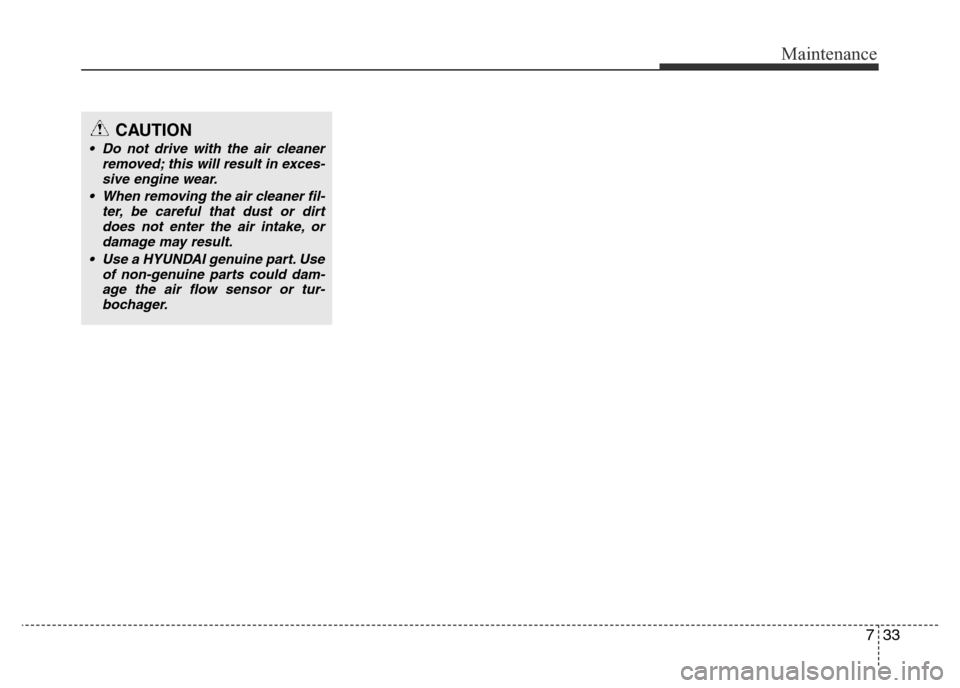
733
Maintenance
CAUTION
• Do not drive with the air cleaner
removed; this will result in exces-
sive engine wear.
• When removing the air cleaner fil-
ter, be careful that dust or dirt
does not enter the air intake, or
damage may result.
• Use a HYUNDAI genuine part. Use
of non-genuine parts could dam-
age the air flow sensor or tur-
bochager.
Page 362 of 425
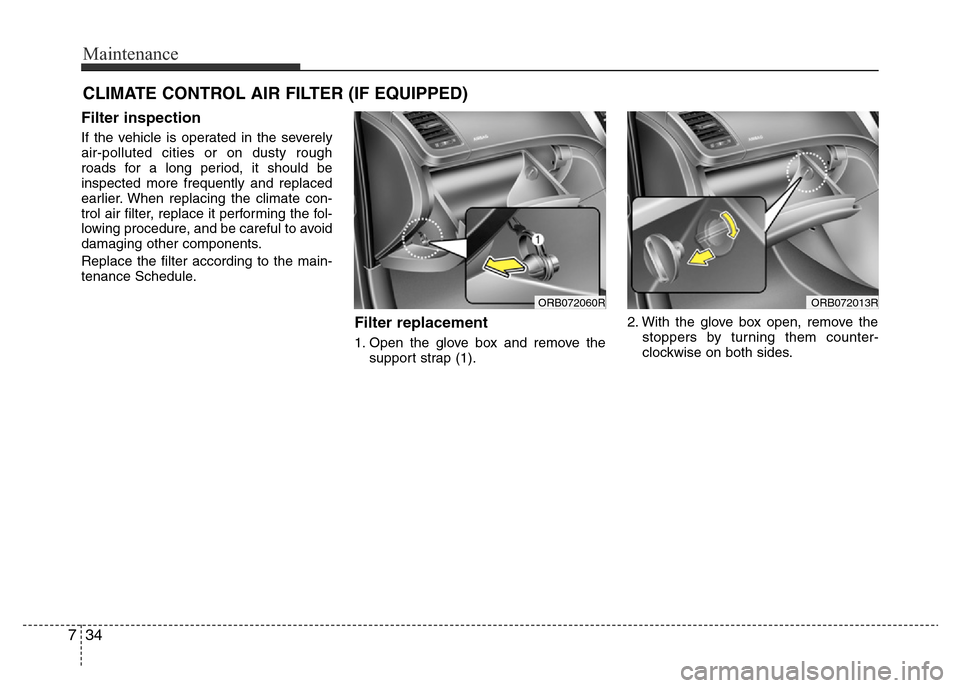
Maintenance
34 7
CLIMATE CONTROL AIR FILTER (IF EQUIPPED)
Filter inspection
If the vehicle is operated in the severely
air-polluted cities or on dusty rough
roads for a long period, it should be
inspected more frequently and replaced
earlier. When replacing the climate con-
trol air filter, replace it performing the fol-
lowing procedure, and be careful to avoid
damaging other components.
Replace the filter according to the main-
tenance Schedule.
Filter replacement
1. Open the glove box and remove the
support strap (1).2. With the glove box open, remove the
stoppers by turning them counter-
clockwise on both sides.
ORB072013RORB072060R
Page 363 of 425
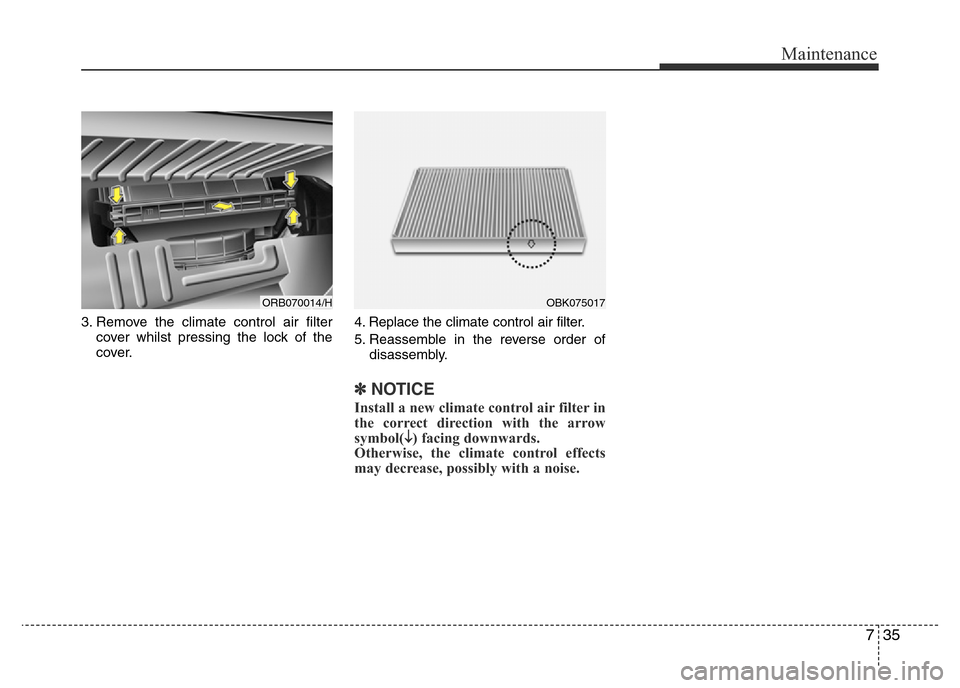
735
Maintenance
3. Remove the climate control air filter
cover whilst pressing the lock of the
cover.4. Replace the climate control air filter.
5. Reassemble in the reverse order of
disassembly.
✽NOTICE
Install a new climate control air filter in
the correct direction with the arrow
symbol(
↓) facing downwards.
Otherwise, the climate control effects
may decrease, possibly with a noise.
OBK075017ORB070014/H
Page 364 of 425
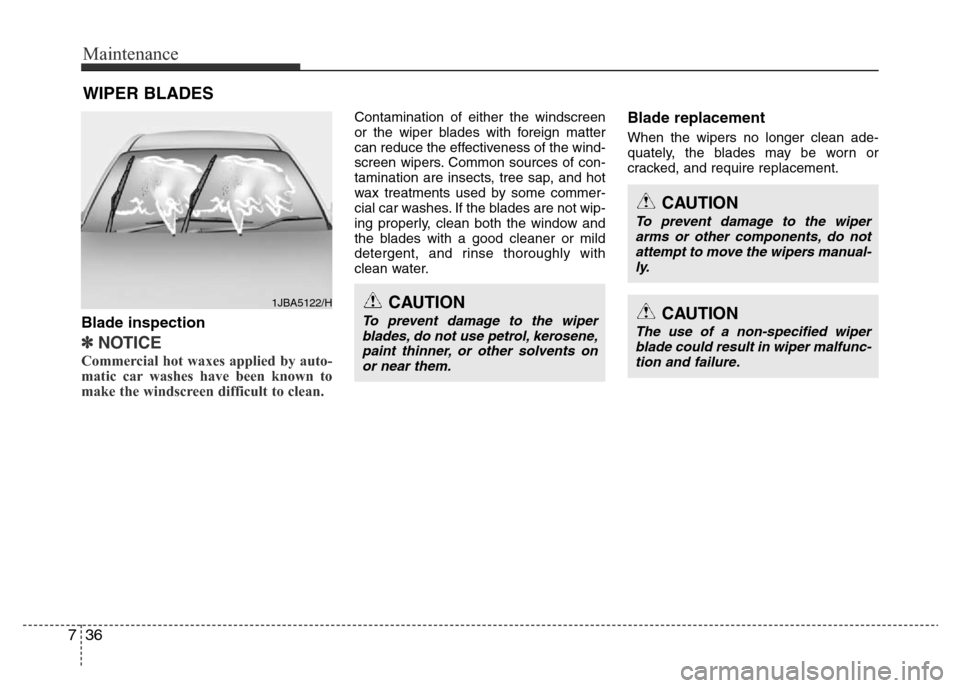
Maintenance
36 7
WIPER BLADES
Blade inspection
✽NOTICE
Commercial hot waxes applied by auto-
matic car washes have been known to
make the windscreen difficult to clean.
Contamination of either the windscreen
or the wiper blades with foreign matter
can reduce the effectiveness of the wind-
screen wipers. Common sources of con-
tamination are insects, tree sap, and hot
wax treatments used by some commer-
cial car washes. If the blades are not wip-
ing properly, clean both the window and
the blades with a good cleaner or mild
detergent, and rinse thoroughly with
clean water.Blade replacement
When the wipers no longer clean ade-
quately, the blades may be worn or
cracked, and require replacement.
1JBA5122/HCAUTION
To prevent damage to the wiper
blades, do not use petrol, kerosene,
paint thinner, or other solvents on
or near them.
CAUTION
To prevent damage to the wiper
arms or other components, do not
attempt to move the wipers manual-
ly.
CAUTION
The use of a non-specified wiper
blade could result in wiper malfunc-
tion and failure.
Page 365 of 425
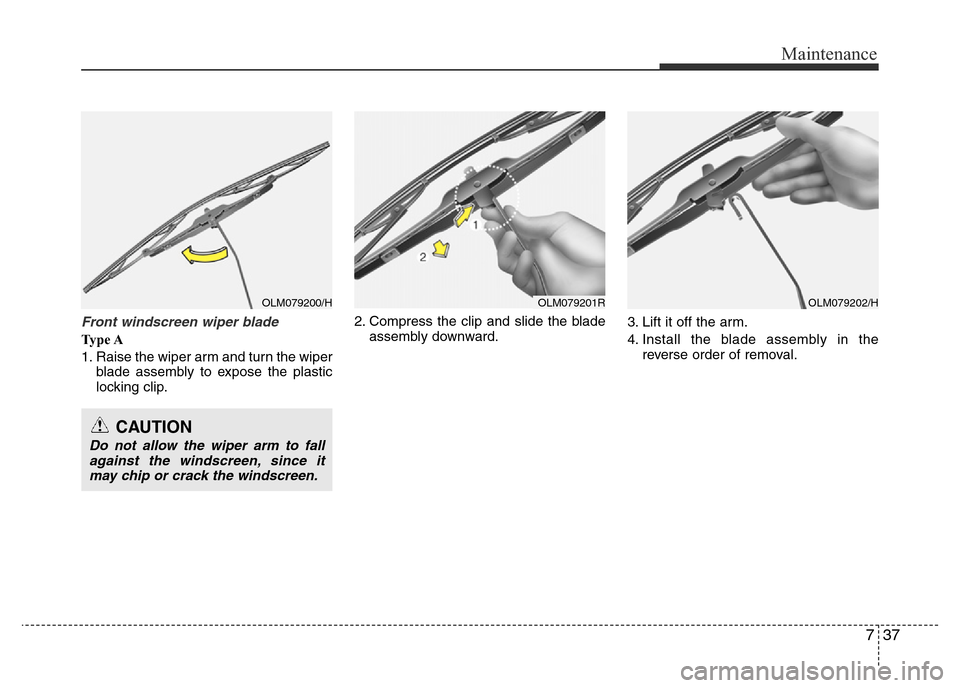
737
Maintenance
Front windscreen wiper blade
Ty p e A
1. Raise the wiper arm and turn the wiper
blade assembly to expose the plastic
locking clip.2. Compress the clip and slide the blade
assembly downward.3. Lift it off the arm.
4. Install the blade assembly in the
reverse order of removal.
OLM079200/HOLM079201ROLM079202/H
CAUTION
Do not allow the wiper arm to fall
against the windscreen, since it
may chip or crack the windscreen.
Page 366 of 425
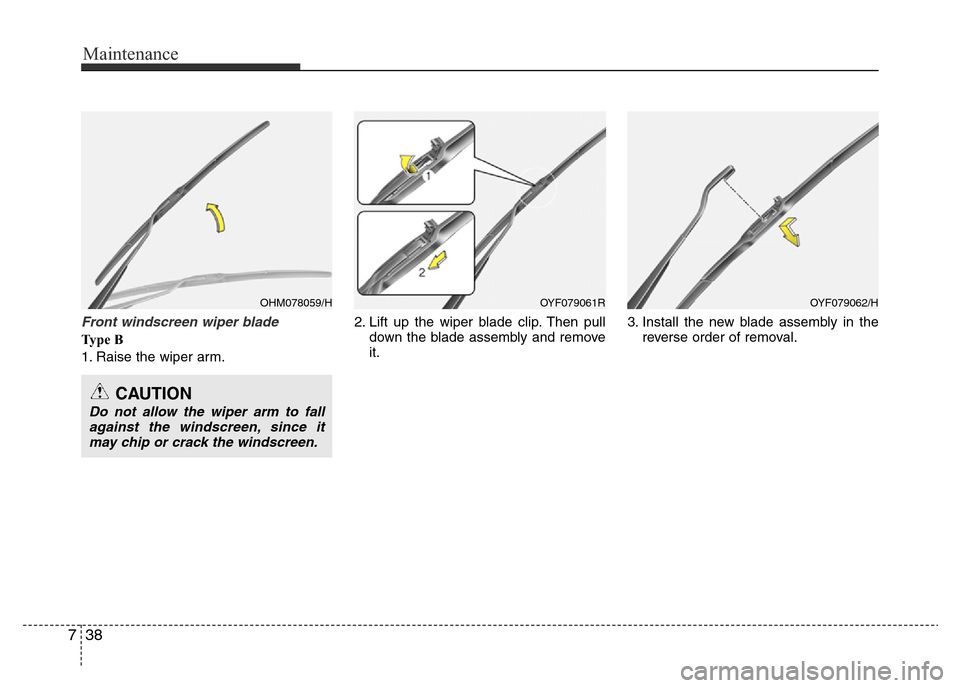
Maintenance
38 7
Front windscreen wiper blade
Ty p e B
1. Raise the wiper arm.2. Lift up the wiper blade clip. Then pull
down the blade assembly and remove
it.3. Install the new blade assembly in the
reverse order of removal.
OHM078059/HOYF079061ROYF079062/H
CAUTION
Do not allow the wiper arm to fall
against the windscreen, since it
may chip or crack the windscreen.
Page 367 of 425
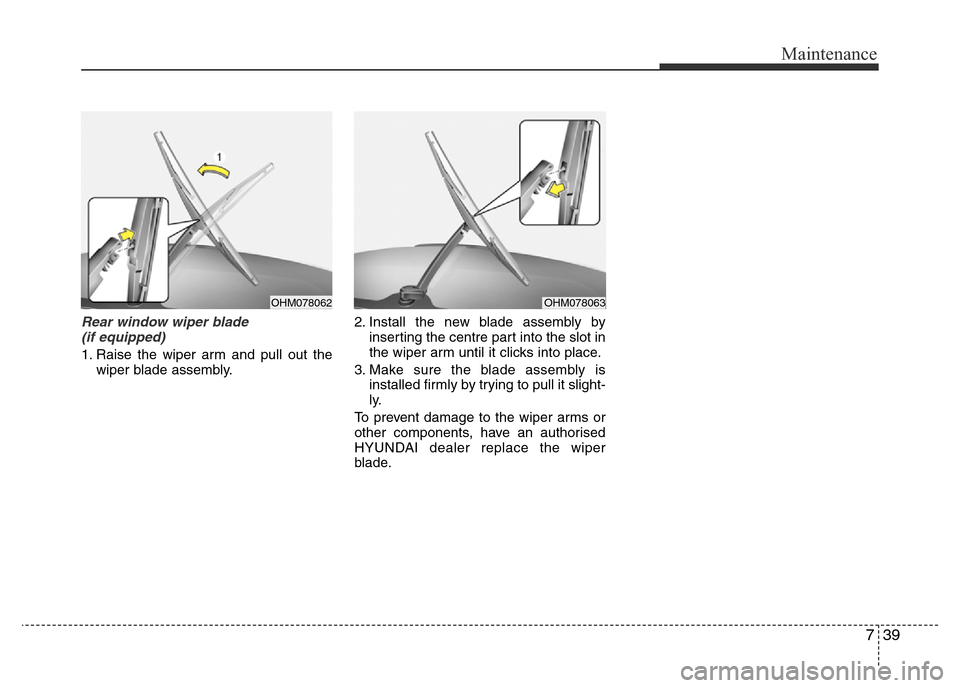
739
Maintenance
Rear window wiper blade
(if equipped)
1. Raise the wiper arm and pull out the
wiper blade assembly.2. Install the new blade assembly by
inserting the centre part into the slot in
the wiper arm until it clicks into place.
3. Make sure the blade assembly is
installed firmly by trying to pull it slight-
ly.
To prevent damage to the wiper arms or
other components, have an authorised
HYUNDAI dealer replace the wiper
blade.
OHM078062OHM078063
Page 368 of 425
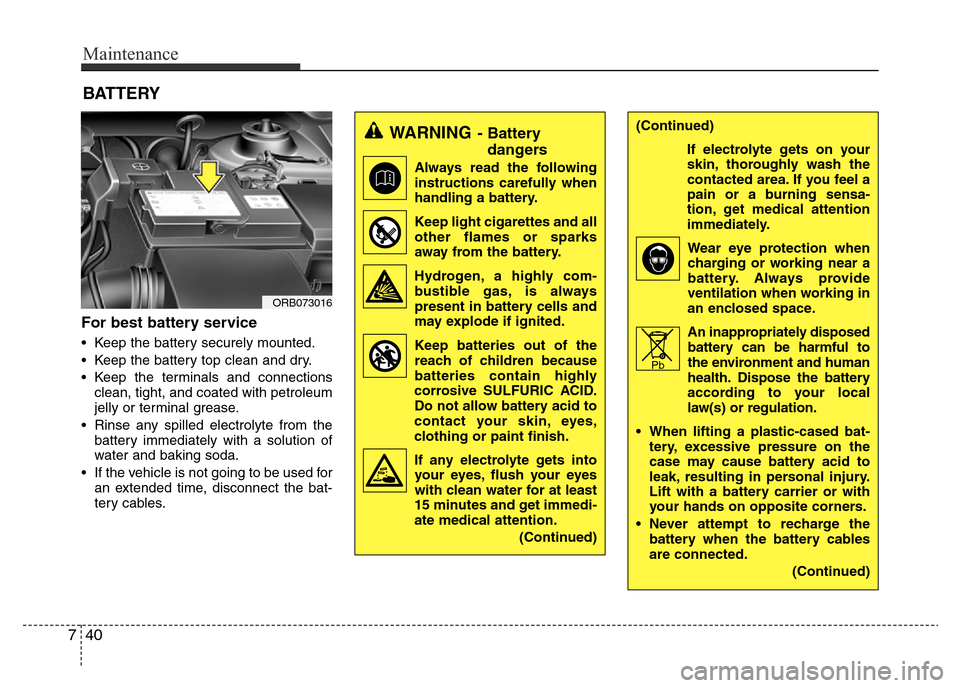
Maintenance
40 7
BATTERY
For best battery service
• Keep the battery securely mounted.
• Keep the battery top clean and dry.
• Keep the terminals and connections
clean, tight, and coated with petroleum
jelly or terminal grease.
• Rinse any spilled electrolyte from the
battery immediately with a solution of
water and baking soda.
• If the vehicle is not going to be used for
an extended time, disconnect the bat-
tery cables.
WARNING- Battery
dangers
Always read the following
instructions carefully when
handling a battery.
Keep light cigarettes and all
other flames or sparks
away from the battery.
Hydrogen, a highly com-
bustible gas, is always
present in battery cells and
may explode if ignited.
Keep batteries out of the
reach of children because
batteries contain highly
corrosive SULFURIC ACID.
Do not allow battery acid to
contact your skin, eyes,
clothing or paint finish.
If any electrolyte gets into
your eyes, flush your eyes
with clean water for at least
15 minutes and get immedi-
ate medical attention.
(Continued)
(Continued)
If electrolyte gets on your
skin, thoroughly wash the
contacted area. If you feel a
pain or a burning sensa-
tion, get medical attention
immediately.
Wear eye protection when
charging or working near a
battery. Always provide
ventilation when working in
an enclosed space.
An inappropriately disposed
battery can be harmful to
the environment and human
health. Dispose the battery
according to your local
law(s) or regulation.
• When lifting a plastic-cased bat-
tery, excessive pressure on the
case may cause battery acid to
leak, resulting in personal injury.
Lift with a battery carrier or with
your hands on opposite corners.
• Never attempt to recharge the
battery when the battery cables
are connected.
(Continued)
Pb
ORB073016
Page 369 of 425

741
Maintenance
❈The actual battery label in the vehicle
may differ from the illustration.
Battery capacity label
1. CMF60L-BCI : The HYUNDAI model
name of battery
2. 12V : The nominal voltage
3. 60Ah(20HR) :The nominal capacity
(in Ampere hours)
4. 92RC : The nominal reserve capacity
(in min.)
5. 550CCA :The cold-test current in
amperes by SAE
6. 440A :The cold-test current in
amperes by EN
(Continued)
• The electrical ignition system
works with high voltage. Never
touch these components with the
engine running or the ignition
switched on.
Failure to follow the above warn-
ings can result in serious bodily
injury or death.CAUTION
• When you don’t use the vehicle
for a long time in the low temper-
ature area, separate the battery
and keep it indoors.
• Always charge the battery fully to
prevent the battery case dam-
aged in low temperature area.
• If you connect unauthorised elec-
tronic devices to the battery, the
battery may be discharged. Never
use unauthorised devices.
• Make sure the battery cap is
closed. If the battery cap is not
closed securely, it can malfunc-
tion because the electric compo-
nents are exposed to moisture.
WARNING
Separating the battery from the
vehicle should be done by an
authorised HYUNDAI dealer.
OJD072039 ■Example
Page 370 of 425
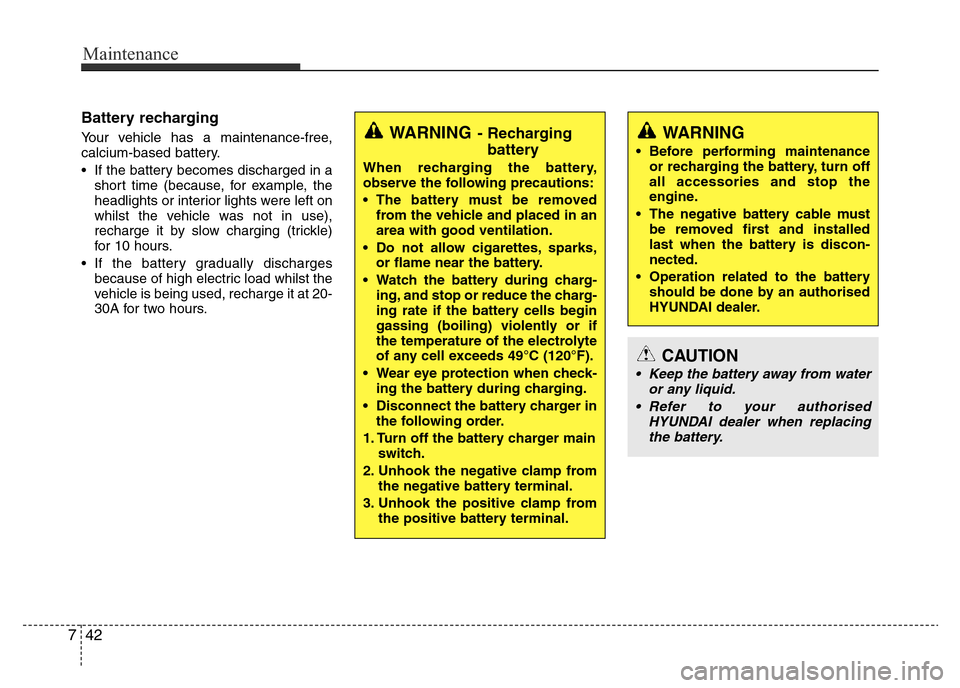
Maintenance
42 7
Battery recharging
Your vehicle has a maintenance-free,
calcium-based battery.
• If the battery becomes discharged in a
short time (because, for example, the
headlights or interior lights were left on
whilst the vehicle was not in use),
recharge it by slow charging (trickle)
for 10 hours.
• If the battery gradually discharges
because of high electric load whilst the
vehicle is being used, recharge it at 20-
30A for two hours.WARNING
• Before performing maintenance
or recharging the battery, turn off
all accessories and stop the
engine.
• The negative battery cable must
be removed first and installed
last when the battery is discon-
nected.
• Operation related to the battery
should be done by an authorised
HYUNDAI dealer.
CAUTION
• Keep the battery away from water
or any liquid.
• Refer to your authorised
HYUNDAI dealer when replacing
the battery.
WARNING- Recharging
battery
When recharging the battery,
observe the following precautions:
• The battery must be removed
from the vehicle and placed in an
area with good ventilation.
• Do not allow cigarettes, sparks,
or flame near the battery.
• Watch the battery during charg-
ing, and stop or reduce the charg-
ing rate if the battery cells begin
gassing (boiling) violently or if
the temperature of the electrolyte
of any cell exceeds 49°C (120°F).
• Wear eye protection when check-
ing the battery during charging.
• Disconnect the battery charger in
the following order.
1. Turn off the battery charger main
switch.
2. Unhook the negative clamp from
the negative battery terminal.
3. Unhook the positive clamp from
the positive battery terminal.